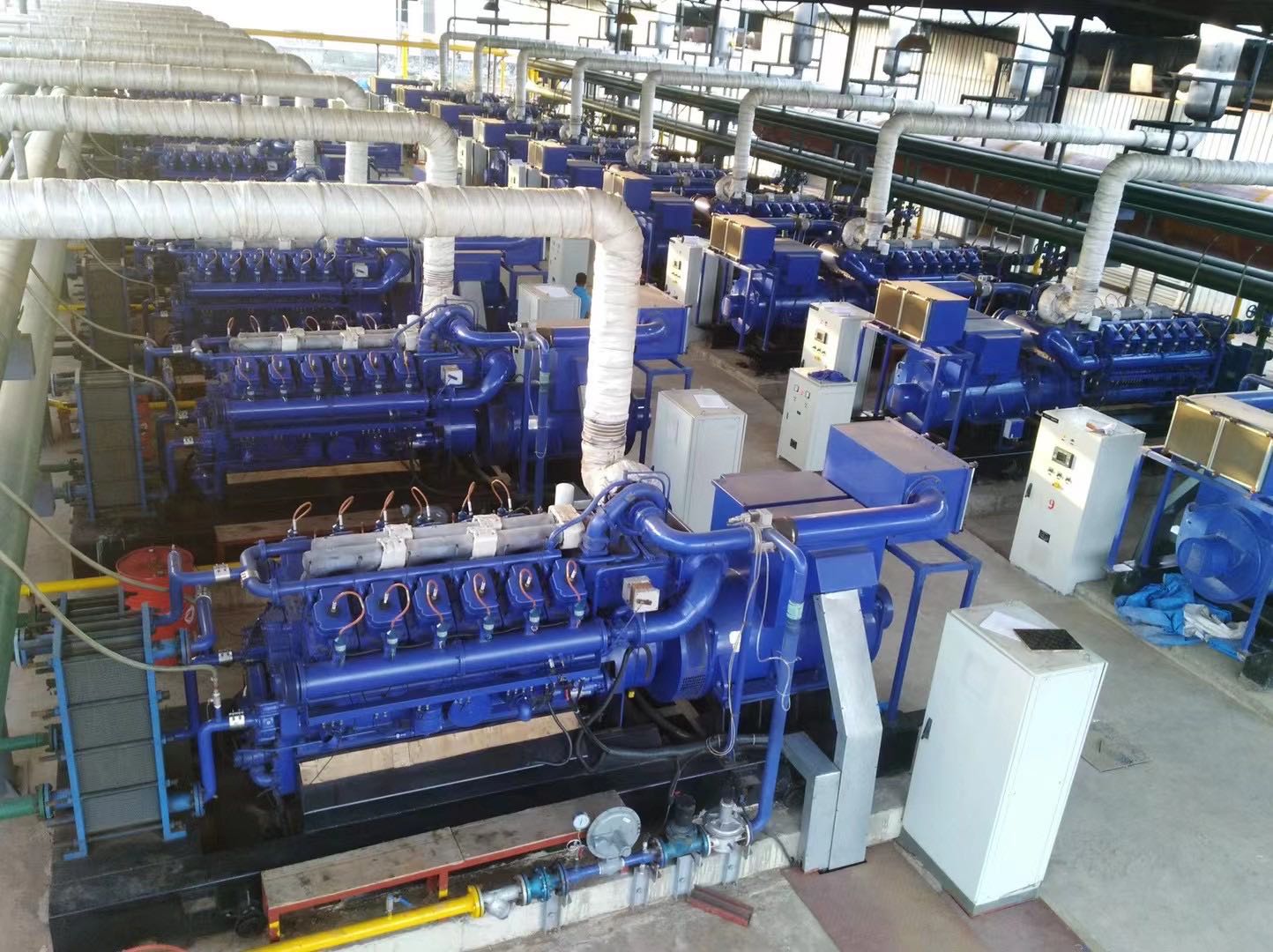 聯系 - 熱線
聯系 - 熱線
0531-69953988

 聯系 - 熱線
聯系 - 熱線
解析氣發電機有什么優勢?
氣發電機組是以氣體燃料或其他能源為動力來源,實現電能轉化的設備系統。其核心構成包括燃料供應系統、動力轉換裝置(如燃氣發動機、汽輪機)及發電組件(發電機)等關鍵部件。工作時,氣體燃料(如天然氣、液化石油氣)在密閉空間內燃燒,將化學能轉化為熱能,推動動力裝置運轉,進而驅動發電機產生電能并入電網。
Gas generator set is an equipment system that uses gas fuel or other energy sources as the power source to achieve the conversion of electrical energy. Its core components include the fuel supply system, power conversion devices (such as gas engines, steam turbines), and power generation components (generators). During work, gas fuels (such as natural gas and liquefied petroleum gas) are burned in a closed space, converting chemical energy into thermal energy to drive the operation of the power plant, which in turn drives the generator to generate electrical energy and integrate it into the power grid.
根據動力轉換原理,氣發電機組可分為兩大類型:一類是以壓縮空氣作為動力源的氣動發電機組,通過高壓空氣推動渦輪葉片實現機械能轉化;另一類則是以蒸汽為動力的蒸汽 - 燃氣混合發電機組,利用燃料燃燒產生的高溫蒸汽驅動汽輪機發電。相較于傳統發電設備,氣發電機組具備體積緊湊、結構簡潔、維護便捷及運行成本低廉等顯著優勢,適用于應急供電、分布式能源系統等多樣化場景。
According to the principle of power conversion, gas turbine generators can be divided into two types: one type is a pneumatic generator set that uses compressed air as a power source, and uses high-pressure air to drive turbine blades to achieve mechanical energy conversion; Another type is a steam gas hybrid generator set powered by steam, which uses high-temperature steam generated by fuel combustion to drive a steam turbine for power generation. Compared to traditional power generation equipment, gas generator sets have significant advantages such as compact size, simple structure, convenient maintenance, and low operating costs, making them suitable for diverse scenarios such as emergency power supply and distributed energy systems.

氣發電機組的出現,為能源供應領域帶來了革命性變革。其不僅能夠滿足工業生產與居民生活的電力需求,更憑借高效的能源轉換方式,成為推動綠色能源轉型的重要力量。在工業領域,氣發電機組可靈活部署于工廠、礦山等場所,通過精準調控發電量,保障生產連續性,同時降低對傳統電網的依賴,有效控制運營成本。此外,氣體燃料燃燒過程中產生的污染物(如二氧化硫、氮氧化物)顯著低于煤炭等傳統能源,契合現代工業節能減排的發展趨勢。
The emergence of gas generators has brought revolutionary changes to the field of energy supply. It can not only meet the electricity needs of industrial production and residential life, but also become an important force in promoting the transformation of green energy through efficient energy conversion methods. In the industrial field, gas-fired power generation units can be flexibly deployed in factories, mines, and other places, ensuring production continuity through precise regulation of power generation, while reducing dependence on traditional power grids and effectively controlling operating costs. In addition, the pollutants generated during the combustion of gas fuels, such as sulfur dioxide and nitrogen oxides, are significantly lower than traditional energy sources such as coal, which is in line with the development trend of modern industrial energy conservation and emission reduction.
從技術特性來看,氣發電機組具有三大核心優勢:其一,采用特種合金材料與精密制造工藝,確保設備在高溫、高壓環境下穩定運行;其二,模塊化設計使其結構清晰,日常檢修與部件更換更為便捷,大幅縮短停機維護時間;其三,較低的初始投資與運行成本,使其在小型分布式電站、備用電源等場景中具備極高的經濟適用性,有效平衡能源供應與成本控制需求。
From the perspective of technical characteristics, gas turbine generators have three core advantages: firstly, they use special alloy materials and precision manufacturing processes to ensure stable operation of the equipment in high temperature and high pressure environments; Secondly, the modular design makes its structure clear, daily maintenance and component replacement more convenient, and greatly reduces the downtime for maintenance; Thirdly, the lower initial investment and operating costs make it highly cost-effective in scenarios such as small distributed power plants and backup power sources, effectively balancing energy supply and cost control needs.
氣發電機組的核心結構由燃料供給系統、動力轉換系統及電力輸出系統三大模塊構成。燃料供給系統包含高壓鼓風機、壓縮機與空氣過濾器,其中高壓鼓風機負責輸送助燃空氣,壓縮機將氣體燃料增壓至指定壓力,空氣過濾器則通過多層濾網攔截雜質,確保進入燃燒室的氣體純凈,提升燃燒效率。動力轉換系統通常采用燃氣發動機或汽輪機,通過燃料燃燒產生的高溫高壓氣體推動活塞或渦輪葉片旋轉,將熱能轉化為機械能。最終,與動力裝置同軸連接的發電機將機械能轉換為穩定的電能,經變壓、整流等處理后輸送至用電終端。
The core structure of a gas generator set consists of three modules: fuel supply system, power conversion system, and power output system. The fuel supply system includes a high-pressure blower, a compressor, and an air filter. The high-pressure blower is responsible for delivering combustion air, the compressor pressurizes the gas fuel to a specified pressure, and the air filter intercepts impurities through multiple layers of filters to ensure the purity of the gas entering the combustion chamber and improve combustion efficiency. Power conversion systems typically use gas engines or steam turbines, which convert thermal energy into mechanical energy by driving pistons or turbine blades to rotate through high-temperature and high-pressure gases generated by fuel combustion. Finally, the generator connected coaxially with the power unit converts mechanical energy into stable electrical energy, which is then transformed, rectified, and transmitted to the power terminal.
這種高效的能量轉換機制,賦予氣發電機組廣泛的應用場景。在商業建筑領域,其可為酒店、寫字樓提供穩定的備用電源,保障應急供電需求;在醫療場所,氣發電機組憑借低噪音、高可靠性的特點,成為生命支持設備的重要電力保障。此外,通過與儲能系統結合,氣發電機組還可參與電力調峰,優化區域能源結構,推動能源供應向智能化、清潔化方向發展。
This efficient energy conversion mechanism endows gas-fired generators with a wide range of application scenarios. In the field of commercial buildings, it can provide stable backup power for hotels and office buildings to ensure emergency power supply needs; In medical facilities, gas generators have become an important power guarantee for life support equipment due to their low noise and high reliability characteristics. In addition, by combining with energy storage systems, gas generators can also participate in power peak shaving, optimize regional energy structure, and promote the development of energy supply towards intelligence and cleanliness.
本文由解析氣發電機組友情奉獻.更多有關的知識請點擊:http://m.newsletterv.cn我們將會對您提出的疑問進行詳細的解答,歡迎您登錄網站留言.
This article is a friendly contribution from the analysis of gas generator sets For more information, please click: http://m.newsletterv.cn We will provide detailed answers to your questions. You are welcome to log in to our website and leave a message
業務分類
Business classification產品推薦
product recommendation聯系方式
Contact Information

截屏,微信識別二維碼